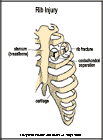
Rib Injury
What is a rib injury?
The 12 ribs on each side of your chest may be bruised, strained, broken, or separated. All of the ribs are attached to the vertebrae (backbone) in the rear. In the front, 10 of them are attached to the sternum (breastbone) by pieces of cartilage. Direct blows to the ribs may bruise or break the ribs or injure the rib cartilage. The ribs may tear away from the cartilage that attaches them to the breastbone. This tearing away from the cartilage is called a costochondral separation.
How does it occur?
Rib injuries usually result from a direct blow to the chest wall. Breaks usually occur in the curved portion of the outer part of the rib cage. A costochondral separation may occur from trauma, when you land hard on your feet, or even when you cough or sneeze violently.
What are the symptoms?
A rib injury causes pain and tenderness over the place of injury. You may have pain when you breathe, move, laugh, or cough.
How is it diagnosed?
Your health care provider will review your symptoms, examine your rib cage, and listen to your lungs. He or she may order a chest x-ray to look for rib damage, lung damage, or bleeding around the lungs.
How is it treated?
To help your injury heal, your provider may recommend that you:
- Rest.
- Put an ice pack over the injured rib for 20 to 30 minutes every 3 to 4 hours for 2 to 3 days or until the pain goes away.
- Take an anti-inflammatory or other pain medication.
- Wear a rib belt, which your health care provider may suggest for very painful injuries. The belt works as a girdle for your chest and helps support your ribs. It limits movement of your ribs when you cough, breathe, or move your body in other ways. This helps decrease pain. If you wear a rib belt, your provider will give you breathing exercises to help you avoid lung complications.
When can I return to my sport or activity?
The goal of rehabilitation is to return you to your sport or activity as soon as is safely possible. If you return too soon you may worsen your injury, which could lead to permanent damage. Everyone recovers from injury at a different rate. Return to your sport or activity will be determined by how soon your ribs recover, not by how many days or weeks it has been since your injury occurred. In general, the longer you have symptoms before you start treatment, the longer it will take to get better.
If you broke a rib, it may take 4 to 6 weeks to heal. Your health care provider may take an x-ray to see that the bone has healed before he or she allows you to return to your activity, especially if it is a contact sport. You may participate in noncontact activities sooner if you can do so without pain in your ribs and without pain when you breathe. If you have bruised your ribs or separated the cartilage from the ribs, you may return to your activity when you can do so without pain.
How can I prevent a rib injury?
Ribs are often injured in accidents that are not preventable. However, in contact sports such as football it is important to wear appropriate protective equipment.

